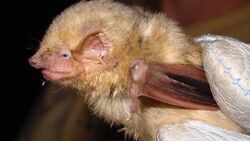Biology:Dasypterus
| Dasypterus | |
|---|---|

| |
| Dasypterus xanthinus | |
| Scientific classification | |
| Domain: | Eukaryota |
| Kingdom: | Animalia |
| Phylum: | Chordata |
| Class: | Mammalia |
| Order: | Chiroptera |
| Family: | Vespertilionidae |
| Genus: | Lasiurus |
| Subgenus: | Dasypterus Peters, 1870 |
| Species | |
|
See text | |
Dasypterus is a subgenus of Lasiurus. Collectively, members of Lasiurus (Dasypterus) are referred to as the yellow bats.[1]
Taxonomy
| ||||||||||||||||||||||||||||||||||||||||||||||||||||||||||||||||||||||||||||||
| Relationship of the three genera formerly included within Lasiurus, based on an analysis of nuclear and mitochondrial DNA.[2] |
Based on genetic divergence within Lasiurus, Baird et al. recommended that the hoary bats be recognized as a separate genus, Aeorestes. They additionally recommended that Dasypterus should be elevated from a subgenus to a genus as well.[1] However, as Lasiurus was previously monophyletic, some authors see the creation of two new genera—Aeorestes and Dasypterus—as a solution to something that was not a problem.[3][4] Teta advocated using Aeorestes as a subgenus and retaining the usage of Dasypterus as such.[5]
In a 2017 follow-up to their 2015 study, Baird et al. again expressed that Aeorestes, Dasypterus, and Lasiurus should be separate genera comprising the tribe Lasiurini. They stated that the genetic distance of the three genera was much greater than observed between other bat genera, on average. In contrast to the average of 12.0% inter-generic divergence reported from another study on bats, Aeorestes and Dasypterus varied 18.79%; Aeorestes and Lasiurus varied 19.05%; and Dasypterus and Lasiurus varied 19.79%.[2]
Species
The subgenus consists of the following four species:
- Southern yellow bat (Lasiurus ega)
- Cuban yellow bat (Lasiurus insularis)
- Northern yellow bat (Lasiurus intermedius)
- Western yellow bat (Lasiurus xanthinus)
References
- ↑ 1.0 1.1 Baird, Amy B.; Braun, Janet K.; Mares, Michael A.; Morales, Juan Carlos; Patton, John C.; Tran, Christina Q.; Bickham, John W. (2015). "Molecular systematic revision of tree bats (Lasiurini): Doubling the native mammals of the Hawaiian Islands". Journal of Mammalogy 96 (6): 1255–1274. doi:10.1093/jmammal/gyv135.
- ↑ 2.0 2.1 Baird, Amy B.; Braun, Janet K.; Engstrom, Mark D.; Holbert, Ashlyn C.; Huerta, Maritza G.; Lim, Burton K.; Mares, Michael A.; Patton, John C. et al. (2017). "Nuclear and mtDNA phylogenetic analyses clarify the evolutionary history of two species of native Hawaiian bats and the taxonomy of Lasiurini (Mammalia: Chiroptera)". PLOS ONE 12 (10): e0186085. doi:10.1371/journal.pone.0186085. PMID 29020097. Bibcode: 2017PLoSO..1286085B.
- ↑ Ziegler, A. C.; Howarth, F. G.; Simmons, N. B. (2016). "A second endemic land mammal for the Hawaiian Islands: a new genus and species of fossil bat(Chiroptera: Vespertilionidae)". American Museum Novitates (3854): 1–52. doi:10.1206/3854.1. https://digitallibrary.amnh.org/bitstream/handle/2246/6641/N3854.pdf?sequence=1&isAllowed=y.
- ↑ Novaes, R. L. M; Garbino, G. S. T; Cláudio, V. C.; Moratelli, R. (2018). "Separation of monophyletic groups into distinct genera should consider phenotypic discontinuities: the case of Lasiurini (Chiroptera: Vespertilionidae)". Zootaxa 4379 (3). doi:10.11646/zootaxa.4379.3.
- ↑ Teta, Pablo (2018). "The usage of subgenera in mammalian taxonomy". Mammalia 83 (3): 209–211. doi:10.1515/mammalia-2018-0059.
External links
Wikidata ☰ Q19713822 entry
 |

